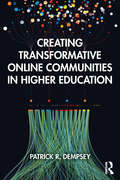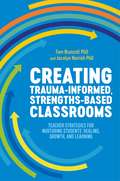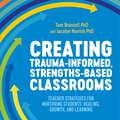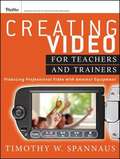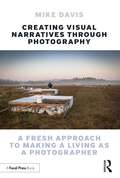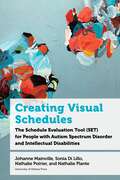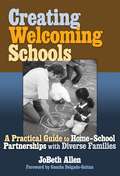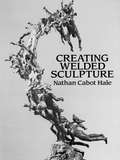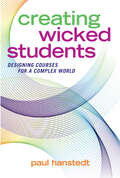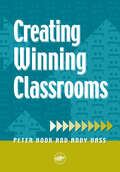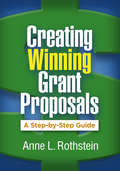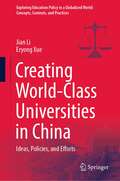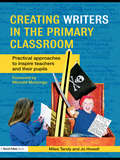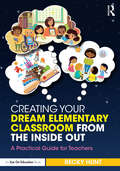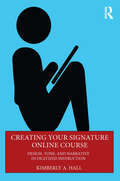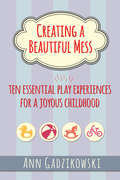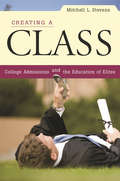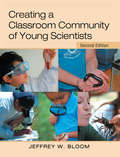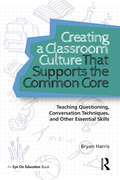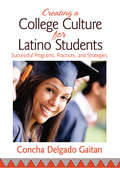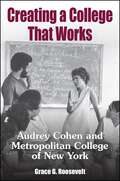- Table View
- List View
Creating Third Spaces of Learning for Post-Capitalism: Lessons from Educators, Artists, and Activists (Critical Social Thought)
by Dipti Desai Gary L. Anderson Ana Inés Heras Carol Anne SpreenIn this book, the authors’ post-capitalist approach to change focuses less on what we need to dismantle and more on what educators and activists are building in its place. Studying schools and other social organizations in the Global North and South, the authors identify and examine some of the most interesting counterhegemonic spaces in both formal and informal education today. They view these spaces through a lens of what Gloria Anzaldua and Homi Bhabha call borderlands or "third spaces." These third spaces are created in-between our lived cultural and social identities (first space) and the dominant culture that seeks to define us (second space). This book seeks to better understand how these third spaces conceive of learning, how they are created, the range of experiences among them, the obstacles they face, how they are sustained over time, and how they have built global networks of solidarity. The creation of global networks of third spaces not only signals a shift in progressive political strategy but also an expansion of what counts as spaces that are educational. This book is well suited to graduate and upper-level undergraduate courses in politics of education, sociology of education, education policy, as well as the humanities, sociology, political science, and the arts.
Creating Transformative Online Communities in Higher Education
by Patrick R. DempseyCreating Transformative Online Communities in Higher Education provides a practical approach for building authentic learning experiences into the design and delivery of online teaching and learning systems. Combining three conceptually related ideas—complexity theory, transformative learning, and the Community of Inquiry—this novel, highly applicable framework enables instructors to create compelling virtual learning experiences for students. As higher education faculty, instructional designers, and graduate students shift from presenting information to creating experiences, the book offers an evidence-based disruption of the current thinking on and practice of course design.
Creating Trauma-Informed, Strengths-Based Classrooms: Teacher Strategies for Nurturing Students' Healing, Growth, and Learning
by Tom Brunzell Jacolyn NorrishWith accessible strategies grounded in trauma-informed education and positive psychology, this book equips teachers to support all students, particularly the most vulnerable. It will help them to build their resilience, increase their motivation and engagement, and fulfil their full learning potential within the classroom. Trauma-informed, strengths-based classrooms are built upon three core aims: to support children to build their self-regulatory capacities, to build a sense of relatedness and belonging at school, and to integrate wellbeing principles that nurture growth and identify strengths. Taking conventional approaches to trauma one step further, teachers may create a classroom environment which helps students to meet their own needs in a healthy way and progress academically. Based on the successful Berry Street education strategies pioneered by the authors, this book also includes comprehensive case studies, learning points and opportunities for self-reflection, fully supporting teachers to implement these strategies within the classroom.
Creating Trauma-Informed, Strengths-Based Classrooms: Teacher Strategies for Nurturing Students' Healing, Growth, and Learning
by Tom Brunzell Jacolyn NorrishWith accessible strategies grounded in trauma-informed education and positive psychology, this audiobook equips teachers to support all students, particularly the most vulnerable. It will help them to build their resilience, increase their motivation and engagement, and fulfil their full learning potential within the classroom.Trauma-informed, strengths-based classrooms are built upon three core aims: to support children to build their self-regulatory capacities, to build a sense of relatedness and belonging at school, and to integrate wellbeing principles that nurture growth and identify strengths. Taking conventional approaches to trauma one step further, teachers may create a classroom environment which helps students to meet their own needs in a healthy way and progress academically.Based on the successful Berry Street education strategies pioneered by the authors, this audiobook also includes comprehensive case studies, learning points and opportunities for self-reflection, fully supporting teachers to implement these strategies within the classroom.(P) 2019 Folio Literary Management
Creating Video for Teachers and Trainers
by Tim SpannausIncorporating advice from message design and multimedia research, this practical guide helps trainers plan, produce, edit, and distribute compelling, professional video, using inexpensive or free consumer-grade equipment and software. Paralleling the work process a teacher or trainer would follow, the guide shows how to "tell a story" that will engage an audience and enables trainers to create instructional videos for a wide variety of uses and traditional and digital media.
Creating Visual Narratives Through Photography: A Fresh Approach to Making a Living as a Photographer
by Mike DavisThis book provides photographers with the foundation to craft more compelling photos from concept all the way through to creation and distribution, on the path to making a living. Based on real-life practice and experience, former National Geographic and White House visual editor, Mike Davis, takes readers on a journey starting with addressing the motivation behind an image and how this determines the rest of the creative process. He goes on to articulate best technical practices to create the narrative through photo composition and what to do with your work after the photos are completed. Each section offers exercises for applied learning and a series of appendices cover assignments structures, a compilation of critical words and concepts, a comprehensive resource guide of organizations, competitions, grants, collectives and agencies, book publishers and printers, and more. This is an ideal resource for students and practitioners alike to gain a more informed understanding of photographic expression and learn how to effectively execute these visions.
Creating Visual Schedules: The Schedule Evaluation Tool (SET) for People with Autism Spectrum Disorder and Intellectual Disabilities (Education)
by Nathalie Plante Johanne Mainville Sonia Di Lillo Nathalie PoirierLes personnes présentant un trouble du spectre de l’autisme (TSA) ou ayant une déficience intellectuelle (DI) ont généralement un déficit sur le plan des fonctions exécutives et de la mémoire et, par conséquent, ont de la difficulté à s’orienter dans le temps.L’outil Schedule Evaluation Tool (SET) a été élaboré en réponse à ces besoins spécifiques, au moyen d’un horaire visuel. Cet outil aide les personnes qui travaillent auprès d’individus qui présentent un TSA ou une DI à déterminer le type d’horaire le mieux adapté à leurs besoins et à leurs capacités et l’intégrer dans leur milieu de vie, favorisant l’autonomie et une meilleure qualité de vie.Le SET comprend le matériel, les protocoles et le manuel permettant aux intervenantes et intervenants et aux professionnelles et professionnels d’effectuer l’évaluation de l’horaire auprès des enfants, des adolescents et des adultes fréquentant différents milieux de vie tels que les milieux de garde éducatifs, le milieu scolaire, le milieu de stage ou d’emploi et le milieu résidentiel.L’outil d’évaluation SET se divise en quatre parties distinctes. La première se réalise par le biais de manipulation d’objets, de photographies, de pictogrammes et de mots dans un contexte d’évaluation formelle. La deuxième et la troisième parties se déroulent directement dans le milieu de vie où il est nécessaire d’implanter l’horaire. La quatrième et dernière partie est administrée sous forme d’entrevue avec l’intervenant connaissant le mieux la personne visée par l’intervention dans le contexte où l’horaire sera introduit.
Creating Welcoming Schools: A Practical Guide To Home-school Partnerships With Diverse Families
by JoBeth Allen Concha Delgado-Gaitan Joseph CarusoThis engaging and rich resource details how schools and diverse families throughout the country have formed partnerships that support and enhance student learning. It is designed for teachers who care deeply about students and welcome diverse families as partners, for parents who want to be active partners in educating their children, and for administrators in diverse schools or districts who know there is no quick fix for building lasting partnerships among families, schools, and the community.
Creating Welded Sculpture (Dover Art Instruction)
by Nathan Cabot HaleIn this generously illustrated guide, newly revised and updated, a well-known American sculptor shares his forty years of experience working with welded sculpture techniques. Nathan Cabot Hale begins with the basic assumption that it is necessary for a sculptor-welder to have the same professional skills as a good job-welder. To help readers gain those skills, he demonstrates both traditional and comparatively new welding methods step by step, including the oxyacetylene technique in modeling small-scale figurative sculpture.Mr. Hale first discusses the basic tools and techniques of welded sculpture, then addresses the construction of abstract and organic shapes and modeling solid figures. This is followed by detailed coverage of finishing techniques, arc welding, and welding large-scale commissioned works. He even dispenses helpful practical advice on the economics of fine art -- exhibiting work, staying alive, searching out public and private support, and more. Over 80 helpful diagrams and more than 100 photographs accompany the text, demonstrating techniques and procedures and depicting works in progress as well as finished works. In a new chapter written specially for this edition, Mr. Hale shares the heartening artistic philosophy he has developed over his long and distinguished career. Sculptors at many levels of accomplishment will find his book instructive and inspiring.
Creating Wicked Students: Designing Courses for a Complex World
by Paul HanstedtIn Creating Wicked Students, Paul Hanstedt argues that courses can and should be designed to present students with what are known as “wicked problems” because the skills of dealing with such knotty problems are what will best prepare them for life after college. As the author puts it, “this book begins with the assumption that what we all want for our students is that they be capable of changing the world….When a student leaves college, we want them to enter the world not as drones participating mindlessly in activities to which they’ve been appointed, but as thinking, deliberative beings who add something to society.”There’s a lot of talk in education these days about “wicked problems”—problems that defy traditional expectations or knowledge, problems that evolve over time: Zika, ISIS, political discourse in the era of social media. To prepare students for such wicked problems, they need to have wicked competencies, the ability to respond easily and on the fly to complex challenges. Unfortunately, a traditional education that focuses on content and skills often fails to achieve this sense of wickedness. Students memorize for the test, prepare for the paper, practice the various algorithms over and over again—but when the parameters or dynamics of the test or the paper or the equation change, students are often at a loss for how to adjust.This is a course design book centered on the idea that the goal in the college classroom—in all classrooms, all the time—is to develop students who are not just loaded with content, but capable of using that content in thoughtful, deliberate ways to make the world a better place. Achieving this goal requires a top-to-bottom reconsideration of courses, including student learning goals, text selection and course structure, day-to-day pedagogies, and assignment and project design. Creating Wicked Students takes readers through each step of the process, providing multiple examples at each stage, while always encouraging instructors to consider concepts and exercises in light of their own courses and students.
Creating Winning Classrooms
by Peter Hook Andy VassThis book offers teachers important insights into the emotional classroom climate necessary for successful and effective learning. Following from the first book, Confident Classroom Leadership, the authors present a range of ideas and understandings to support teachers in proactively building and sustaining an emotionally empowering classroom. The beliefs and behaviors that underpin and develop positive self-esteem and strong motivation in students are described in an accessible and informative format. This not only invites readers to reflect on their teaching style, it also encourages them to comfortably integrate the strategies and ideas into their existing practice. As you would expect from two highly experienced practitioners, the book is firmly based in the reality of today's busy classrooms.
Creating Winning Grant Proposals: A Step-by-Step Guide
by Anne L. RothsteinProviding clear-cut steps for producing each section of a competitive grant proposal, this hands-on book is filled with examples from actual RFPs and proposals, practical tools, and writing tips. Prominent educator and successful proposal writer Anne L. Rothstein shares a systematic process created over decades of experience in the field. She details how to: achieve group consensus around a project; identify likely funding sources; establish need; develop objectives; assemble a Master Project Table and other needed tables, figures, and charts; create an effective logic model; prepare an evaluation; put together a budget; tailor the proposal to meet the requirements of funders; and avoid common errors. Purchasers get access to a Web page where they can download and print the book's 14 reproducible templates in a convenient 8 1/2" x 11" size.
Creating World-Class Universities in China: Ideas, Policies, and Efforts (Exploring Education Policy in a Globalized World: Concepts, Contexts, and Practices)
by Jian Li Eryong XueThis book explores how can we shape “World-class University” in China from the perspectives of ideas, policies and efforts, specifically. It examines the essence and logic of creating world-class universities and disciplines and focuses on the construction of a number of universities and disciplines across a number of historical periods. The book also investigates the improvement of China's education, and the higher education needs to “face modernization, face the world, face the future”. It offers a broader vision to connect with the Chinese higher education system and the international higher education communities contextually.
Creating Writers in the Primary Classroom: Practical Approaches to Inspire Teachers and their Pupils
by Miles Tandy Jo HowellTeachers in English schools have now had ten years of prescriptive national literacy strategies and it is time for a new approach. This book encourages children from their early years to think of themselves as writers who have something to write and know how to write it. Creating Writers in the Primary Classroom offers an exciting and refreshing approach to teaching writing in the primary school with very practical suggestions to help build a community of writers in your school where everyone writes and loves writing. Building on the research of recent years and with whole-curriculum provision, it shows teachers how to actively engage children in the writing process, excite them about what they can achieve and help all children to think of themselves as writers. The book begins with a clear analysis of what real writers really need and has chapters on working outdoors, using the very best of children’s literature, drama and imaginative play, as well as sounds and images. It also features a chapter on practical, productive planning, including two case studies that show the approaches in use at schools. Creating Writers in the Primary Classroom is packed with practical advice, games and strategies for the classroom based on the authors’ successful experience as teachers and in-service providers. These new approaches will enable teachers to get their children up and moving, experiencing what writers experience, feeling what writers feel and, most important of all, writing how writers write.
Creating Writers: A Creative Writing Manual for Schools
by James CarterThis unique and comprehensive text offers an original approach to teaching creative writing by exploring ideas, giving advice, and explaining workshop activities and has many contributors from some of today's most popular children's authors including: Jacqueline Wilson, Roger McGough, Philip Pullman, Malorie Blackman and David Almond.Creating Writers is a practical writing manual for teachers to use with upper primary and lower secondary level pupils that covers poetry, fiction and non-fiction.
Creating Your Dream Elementary Classroom from the Inside Out: A Practical Guide for Teachers
by Becky HuntWhat are the magic ingredients to a dream classroom and how can you create one for your own students? In this inspiring new book, Becky Hunt shows you how to transform the elementary school classroom into a special place where students are excited to learn. You’ll gain practical strategies on key areas such as classroom environment, community, routines, procedures, expectations, lessons, and professionalism. You will discover how to: Design a classroom environment in which students feel safe, happy, and eager to learn; Arrange and facilitate regular class meetings so that students can express themselves freely, without judgement; Maintain professionalism in and out of the workplace; Set guidelines, rules, and expectations that students will understand and respect; Construct a targeted lesson plan with a clear beginning, middle, and end; Approach each day with a positive attitude by managing health and wellness; And much more! Special features in each chapter include a "Tips from the Pros" section and "Reflect and Write" boxes to help you pause and apply the ideas as you go. There are also "Discussion Questions" and "Notes to Trainers and Mentors" so you can easily use the book for new teacher training, induction, book studies, and PLCs. With the practical tools and heartwarming examples in this book, you can have your own dream classroom starting today!
Creating Your Signature Online Course: Design, Tone, and Narrative in Digitized Instruction
by Kimberly A. HallCreating Your Signature Online Course guides educators through the development of engaging, efficient, aesthetically pleasing, and narrative-rich online learning spaces. Despite the availability of numerous visual and textual communication tools and user-friendly learning management systems, instructors and support staff need concrete strategies for designing digital and online higher education courses that emphasize the appeal and relevance of the subject, reflect the instructor’s presence, and inspire students. Grounded in research and theory from psychology, instructional design, user and learner experience design, graphic arts, and storytelling, this book accessibly and practically showcases how teachers can leverage effective multimedia resources alongside their own expertise to meet students’ needs. These fresh insights into instructional goals, learner identity, tonal qualities, narrative aesthetics, student feedback, and more reveal how charismatic virtual course designs can empower learners and tap into their mindsets and literacies.
Creating a Beautiful Mess
by Ann GadzikowskiParents will appreciate Creating a Beautiful Mess because it's fun and helpful. This book isn't about parenting rights or wrongs; it's about playful, joyous play experiences for childhood that are universal. It boils down the essential play experiences in an accessible, practical, and easy way. The chapters represent an optimal balance among experiences that support learning, provide physical activity, encourage creative expression, and promote social and family connections. Ann Gadzikowski is an early childhood educator and the author of several books. She is a frequent presenter at professional conferences on the topics of both early childhood education and gifted education.
Creating a Beautiful Mess
by Ann GadzikowskiParents will appreciate Creating a Beautiful Mess because it's fun and helpful. This book isn't about parenting rights or wrongs; it's about playful, joyous play experiences for childhood that are universal. It boils down the essential play experiences in an accessible, practical, and easy way. The chapters represent an optimal balance among experiences that support learning, provide physical activity, encourage creative expression, and promote social and family connections.Ann Gadzikowski is an early childhood educator and the author of several books. She is a frequent presenter at professional conferences on the topics of both early childhood education and gifted education.
Creating a Campus-Wide Culture of Student Success: An Evidence-Based Approach to Supporting Low-Income, Racially Minoritized, and First-Generation College Students
by Adrianna Kezar Rosemary J. Perez Ronald E. Hallett Joseph A. KitchenOffering a new approach to institutional practices, this book describes evidence-based strategies to create a campus culture conducive to truly supporting all students. We are at a critical crossroads in higher education, where large numbers of low-income, racially minoritized, and first-generation college students – referred to in this book as "at-promise students" – are attending college in greater numbers than ever, yet access has not translated to significantly improved retention and graduation rates. This book, therefore, proposes a realignment of existing initiatives to create campus-wide support through a new model of coordination. The ideas presented in this book are the culmination of one of the largest studies of comprehensive college support programs for at-promise students. Chapters include illustrations of the key concepts and promising practices of the Promoting At-promise Student Success (PASS) Project, as well as guiding questions that can be used to facilitate conversations on campus. In this helpful resource, the authors address how student supports are delivered in validating ways, rather than focusing solely on what supports are offered, as has typically been the way institutions address the issues that at-promise students face. This book is intended to provide guidance and support to educators who want to be a part of changing how higher education supports at-promise students toward increased equity.
Creating a Class: College Admissions and the Education of Elites
by Mitchell L. StevensIn real life, Mitchell Stevens is a professor in bustling New York. But for a year and a half, he worked in the admissions office of a bucolic New England college that is known for its high academic standards, beautiful campus, and social conscience. Ambitious high schoolers and savvy guidance counselors know that admission here is highly competitive. But creating classes, Stevens finds, is a lot more complicated than most people imagine. Admissions officers love students but they work for the good of the school. They must bring each class in "on budget," burnish the statistics so crucial to institutional prestige, and take care of their colleagues in the athletic department and the development office. Stevens shows that the job cannot be done without "systematic preferencing," and racial affirmative action is the least of it. Kids have an edge if their parents can pay full tuition, if they attend high schools with exotic zip codes, if they are athletes--especially football players--and even if they are popular. With novelistic flair, sensitivity to history, and a keen eye for telling detail, Stevens explains how elite colleges and universities have assumed their central role in the production of the nation's most privileged classes. Creating a Class makes clear that, for better or worse, these schools now define the standards of youthful accomplishment in American culture more generally.
Creating a Classroom Community of Young Scientists
by Jeffrey W. BloomCreating a Classroom Community of Young Scientists helps teachers - both pre-service and in-service - to develop exciting science programs in their classrooms. This book provides the groundwork for designing and implementing a science program that takes into account the latest research in teaching and learning. It provides an approach that will capture children's imaginations, stimulate their curiosity and create a strong foundation for their continued interest in, and appreciation of, science and the world in which they live. The book is designed to be user-friendly, and offers an approach to teaching science that is exciting for teachers as well. This thoroughly revised, second edition focuses on making inquiry more explicit both in terms of the process of inquiry and teaching in ways that capitalize on children's curiosity and questions. New material has also been added on U.S. and Canadian science standards, as well as professional standards for teachers.
Creating a Classroom Culture That Supports the Common Core: Teaching Questioning, Conversation Techniques, and Other Essential Skills
by Bryan HarrisIs your classroom culture conducive to the expectations of the Common Core? Teaching content is not enough; students need a classroom structure and atmosphere that will help them learn key academic skills. This practical book will show you how to transform your classroom culture, raise the level of rigor, encourage higher-level questioning and critical thinking, and promote academic discussions. You will also find out how to adjust your classroom management techniques so that students learn to regulate themselves while completing these higher-level tasks. Special Features in Each Chapter: Key Idea—a summary of the essential idea that will be addressed in the chapter Practical strategies—a variety of easy-to-implement ideas that you can try right away Connections to the Common Core State Standards—how the skills taught in this book will help students meet the standards Reflection Questions—thoughtful questions that will help teachers apply their learning to their own classrooms. These questions can be answered independently or used in book study groups. Extend Your Knowledge—creative ideas for extending your knowledge beyond the ideas in this book
Creating a College Culture for Latino Students: Successful Programs, Practices, and Strategies
by Concha Delgado GaitanHelp your Latino students become college-bound! This groundbreaking book shows how educators can help Latino students overcome the barriers that prevent them from attending college. Delgado Gaitan, an award-winning professor, scholar, and first-generation Latina college graduate, shares winning strategies from the nation’s most outstanding college-readiness programs for Latino learners. You'll find: Guidance on creating a "college culture" in elementary, middle, and secondary school, both within the classroom and throughout the building Insights on working with families and community organizations to promote Latino students' school achievement and college goals Best practices for coaching students, including five essentials for college-preparedness
Creating a College That Works: Audrey Cohen and Metropolitan College of New York
by Grace G. RooseveltIn 1964 educational activist Audrey Cohen and her colleagues developed a unique curricular structure that enables urban college students to integrate their academic studies with meaningful work in community settings. Creating a College That Works chronicles Cohen's efforts to create an innovative educational model that began with the Women's Talent Corps, evolvied into the College for Human Services, and finally became, in 2002, what is now Metropolitan College of New York (MCNY), a fully accredited institution of higher education that offers bachelor's and master's degrees.Focusing her attention on the major players in the development of MCNY, Grace G. Roosevelt provides a ringside seat during the years of turbulence, hope, and innovation in the 1960s and '70s. She captures the life of a visionary educational leader while situating Cohen's ideas within the history of progressive education. Cohen and her colleagues, facing great opposition, petitioned and marched, and were harassed and rebuffed. But they persevered, and today the college they founded continues to graduate hundreds of students dedicated to improving their communities, workplaces, and schools in the New York metropolitan area. Woven throughout the narrative are the changing dynamics of the civil rights movement, questions about women's leadership roles, and stories of how adults have transformed their lives through Cohen's innovative educational model.

